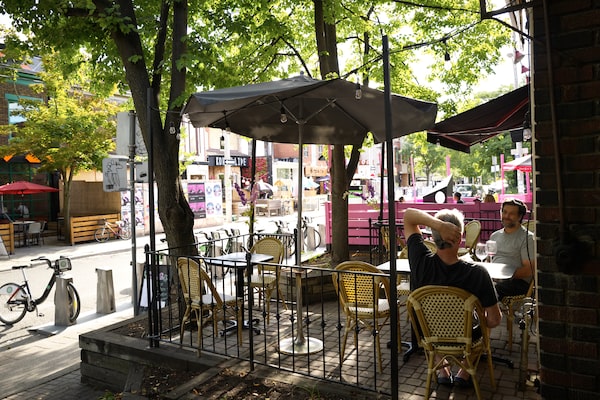
Baldwin Street in downtown Toronto.Thomas Bollmann
An economic rebound in commercial retail amid the continuing COVID-19 pandemic may be right under our feet – in the sidewalks we walk on. The key, however, depends on how wide they are.
The positive effects of wide sidewalks as opposed to narrow ones are easy to see, according to Val Rynnimeri, an associate professor of architecture at the University of Waterloo’s School of Architecture. Commercial streets that have them are experiencing a faster return of people and therefore business than those that don’t.
Perhaps the best example, he says, is Baldwin Street in downtown Toronto. Home to a concentrated cluster of bars, restaurants and cafés that have taken advantage of wide sidewalks with long rows of patios, the stretch between McCaul and Beverley streets is surprisingly vibrant.

Baldwin Street is home to a concentrated cluster of bars, restaurants and cafés that have taken advantage of wide sidewalks with long rows of patios.Thomas Bollmann
This development, which resembles an outdoor mall, is a possible template for how Toronto and other cities go forward as the pandemic continues.
“That might be the most COVID-friendly street in the city: big sidewalks, places to spill out onto and a nice backdrop [of residential homes],” Prof. Rynnimeri says. “That’s what retail in a post-COVID world should look like.”
With health officials saying that virus transmission is less likely outdoors than indoors, many Canadian cities have adopted temporary measures to allow businesses to extend their operations onto streets. The problem, however, is that not many streets – or sidewalks specifically – are designed to handle such a shift, even in the short term.

Many Canadian cities have adopted temporary measures to allow businesses to extend their operations onto streets.Thomas Bollmann
Prof. Rynnimeri says that with COVID-19 likely persisting for some time, commercial real estate operators and developers are going to be forced to adapt to this reality. Projects that are currently under development may need to consider the role that sidewalk widths play, not just over the course of the pandemic, but also in the long-term prosperity of an area.
Wide sidewalks played an historic role in establishing downtown Toronto as a retail destination, he adds – particularly the section of Queen Street West between Spadina Avenue and McCaul, just a few blocks from the retail and restaurant cluster on Baldwin Street.
Queen Street West started becoming a hub in the late 1970s after a host of discos opened up further north in Yorkville. Hipster crowds, looking for an alternative scene, migrated south where they found the Horseshoe Tavern, the Rivoli, the BamBoo and other bars with their ample sidewalk patio spaces.

Queen Street West in downtown Toronto.Thomas Bollmann
The crowds they drew eventually led to a variety of hip businesses such as clothing stores and record shops popping up, which established the area as some of the most valuable commercial real estate in the city.
“That was really the beginning of Queen Street as a place to go to,” Prof. Rynnimeri says. “It was about being able to spill out into the street.”
Michael Hannay, a principal with Toronto-based design firm MBTW Group, says businesses that have been situated on wide sidewalks have indeed traditionally benefited, especially in the case of restaurants and bars with patios.
But despite that, they’re all going to have to contend with the inevitability of worse weather.
“Come winter, the advantage of how wide your sidewalk is goes out the window,” he says. “Streetscape design isn’t going to be a factor at all because an enclosed, heated patio is indoor space. It’s not going to be a factor for much longer.”

Queen Street started becoming a hub in the late 1970s after a host of discos opened up further north in Yorkville.Thomas Bollmann
Other urban design experts suggest that’s where innovation is needed.
A number of winter-prone countries and municipalities have experimented with various cold-fighting technologies over the past few years. The Netherlands, for example, has been building heated bike paths in its cities. Vancouver, meanwhile, created a system that drew heat from sewers to help warm the Olympic Village in 2010.
“We do need to think creatively and be willing to experiment,” says Shauna Brail, associate professor at the Institute for Management and Innovation at the University of Toronto. “This is the push we didn’t know we needed.”
Prof. Brail points to work done by Toronto-based architecture firm Partisans for Google sister company Sidewalk Labs on “building raincoats,” unveiled last year, as an example of the innovation that cities will need more of, in part to keep commercial real estate alive.
The “raincoat” is essentially an awning consisting of hexagonal plastic panels that attaches to the front of a building. Its purpose is twofold – to protect the building from the elements and to provide a sheltered space for outdoor activity, such as a patio.

A variety of hip businesses such as clothing stores and record shops established the Queen Street area as some of the most valuable commercial real estate in the city.Thomas Bollmann
Alexander Josephson, an architect and co-founder of Partisans, says the raincoats were experimental prototypes that may not end up being deployed because of intellectual property issues associated with Sidewalk Labs, which pulled out of Toronto earlier this year.
Nevertheless, he expects to see more of these types of experiments – on how to make streets more like malls, regardless of the weather – now that the pandemic is forcing a more liberal approach to city planning and how commercial real estate is used.
“It’s a watershed moment in the decolonization of Toronto streets,” he says, referring to historical, long-standing puritanism – especially as it pertains to alcohol regulation – in how city government views property. If there’s a bright side to the pandemic, it’s that novel ways of using streets and properties will now get more consideration.
“It took COVID and an economic crisis for us to let go,” he adds.